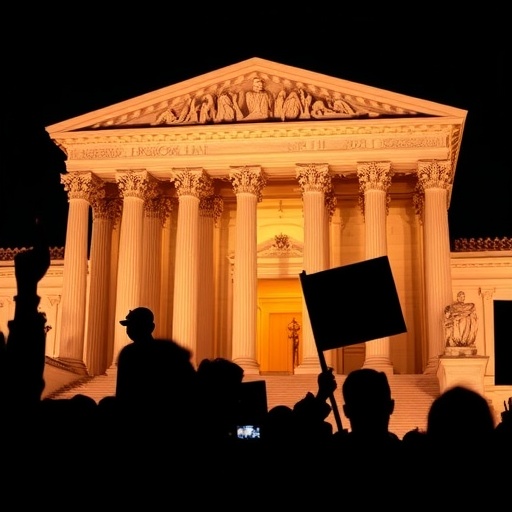Supreme Court Poised to Redefine Voting Rights Act in Landmark Case: Implications for Elections and Minority Voters
In a move that could fundamentally alter the landscape of American democracy, the U.S. Supreme Court has agreed to hear a high-stakes case challenging key provisions of the Voting Rights Act. At the center of this legal battle is whether states can implement election laws that disproportionately affect minority voters without facing federal scrutiny under Section 2 of the landmark 1965 legislation. With oral arguments scheduled for early next year, the decision could either fortify or dismantle protections that have safeguarded voter access for decades, just as the nation gears up for another contentious presidential election cycle.
The Supreme Court‘s involvement signals a potential tipping point in ongoing debates over voter suppression. Civil rights advocates warn that a ruling against robust enforcement could embolden states to enact restrictive measures, echoing the post-2013 Shelby County v. Holder era when preclearance requirements were gutted. This case, tentatively named Texas v. NAACP, stems from a federal district court’s finding that Texas’s recent voter ID laws and polling place consolidations created undue burdens on Black and Latino communities, reducing turnout by an estimated 5-10% in affected areas according to preliminary studies from the Brennan Center for Justice.
Texas Voter Law Sparks Federal Showdown
The origins of this Supreme Court case trace back to 2022, when Texas passed Senate Bill 7, a sweeping elections overhaul that included stricter mail-in ballot rules, bans on drive-thru voting, and expanded poll watcher powers. Critics, including the NAACP and League of Women Voters, argued that these changes targeted urban and rural minority voters who rely on accessible voting methods. In a 2023 ruling, the U.S. District Court for the Western District of Texas sided with plaintiffs, declaring parts of the law violative of the Voting Rights Act because they resulted in disparate impacts without sufficient justification.
“This isn’t about security; it’s about suppression,” said Marc Elias, a prominent voting rights attorney representing the challengers. “The data shows Black voters in Texas waited an average of 45 minutes longer at polls in 2020 compared to white voters, and these new laws will only exacerbate that inequality.” Federal statistics from the U.S. Election Assistance Commission corroborate this, revealing that in the 2020 elections, 25% of Black voters and 23% of Latino voters reported barriers like long lines or ID issues, versus just 12% of white voters.
Texas officials, led by Attorney General Ken Paxton, appealed directly to the Supreme Court, contending that Section 2’s disparate impact standard is too vague and burdensome for states to defend their election integrity measures. “Every state has a compelling interest in secure elections,” Paxton stated in court filings. “Requiring endless litigation over every policy chills innovation and erodes public trust.” This argument draws on the Court’s conservative majority’s skepticism toward expansive federal oversight, as seen in previous decisions limiting the Voting Rights Act‘s reach.
Reviving the Ghosts of Shelby County
To understand the gravity of this Supreme Court case, one must revisit the 2013 Shelby County v. Holder decision, which struck down the Voting Rights Act‘s formula for identifying jurisdictions needing federal preclearance before changing voting laws. That ruling unleashed a wave of restrictive measures across the South and beyond—24 states introduced 99 bills restricting voting access by 2016, according to the National Conference of State Legislatures. Voter turnout among minority voters dipped noticeably; for instance, Black participation in midterm elections fell from 66% in 2008 to 60% in 2014, per U.S. Census Bureau data.
Section 2 of the Voting Rights Act, which prohibits practices that dilute minority voters‘ influence, became the last bulwark after Shelby. But challengers in the current case seek to narrow it further by arguing that only intentional discrimination, not unintentional disparate impacts, should trigger liability. This echoes the 2021 Brnovich v. Democratic National Committee ruling, where the Court upheld Arizona’s voting restrictions and set a high bar for Voting Rights Act claims.
Legal scholars like those at the Harvard Law Review note that such a shift could invalidate hundreds of ongoing lawsuits nationwide. “If the Court adopts Texas’s view, it would effectively neuter Section 2,” warned Professor Heather Gerken of Yale Law School in a recent op-ed. “We’ve seen gerrymandered districts in states like Georgia and Alabama that pack minority voters into few seats, minimizing their power in elections. Without disparate impact protections, these maps could stand unchallenged.”
Historical context underscores the stakes. The Voting Rights Act was born from the bloodshed of the Civil Rights Movement, with events like Bloody Sunday in Selma galvanizing Congress to pass the law in 1965. It boosted Black voter registration in the South from 29% to 67% within a few years, transforming elections and electing trailblazers like John Lewis. Today, with the minority voters comprising 30% of the electorate—projected to rise to 40% by 2030 per Pew Research—any erosion could sway battleground states.
Civil Rights Groups Rally Against Potential Rollback
As the Supreme Court prepares to delve into this case, a coalition of over 100 civil rights organizations has mobilized, filing amicus briefs that paint a dire picture for minority voters. The ACLU’s brief highlights data from the 2022 midterms, where new laws in five states led to a 7% drop in Latino turnout in key congressional districts, potentially flipping seats in Arizona and Nevada.
“The Voting Rights Act isn’t just law; it’s the promise of democracy,” declared NAACP President Derrick Johnson at a Washington rally last month. “If the Court sides with Texas, we’re looking at a return to Jim Crow-era tactics dressed in modern clothes—fewer polling sites in Black neighborhoods, ID requirements that hit the poor hardest.” Supporting statistics from the Sentencing Project show that 1 in 13 Black adults lacks a current photo ID, compared to 1 in 42 white adults, making voter ID laws a de facto barrier.
Democratic leaders have echoed these concerns. Senate Majority Leader Chuck Schumer called the case “an existential threat to fair elections,” urging filibuster reform to pass the John Lewis Voting Rights Advancement Act, which stalled in 2022. On the Republican side, figures like House Speaker Mike Johnson defend state autonomy, arguing that “fraud prevention is paramount” amid unsubstantiated claims of widespread irregularities in 2020.
Public opinion polls reflect the divide: A 2023 Gallup survey found 62% of Americans support strengthening the Voting Rights Act, with 78% of Black respondents viewing it as essential for protecting minority voters. Yet, partisan gaps persist, with only 45% of Republicans favoring expanded federal role in elections.
Election Experts Predict Ripple Effects Nationwide
Beyond Texas, the implications of this Supreme Court case could reverberate through all 50 states, particularly in swing districts where minority voters hold sway. Election law expert Rick Hasen of UC Irvine predicts that a pro-state ruling would greenlight similar laws in Florida, Georgia, and North Carolina—states that already face Section 2 challenges over redistricting.
“Imagine the 2024 elections without Section 2’s shield,” Hasen wrote in his blog, Election Law Blog. “Gerrymanders could lock in GOP majorities for a decade, suppressing turnout among growing demographics like young Latinos and urban Blacks.” Data from the Princeton Gerrymandering Project illustrates this: In 2022, North Carolina’s maps diluted Black voting power by 15%, costing Democrats three House seats.
Economists have also weighed in, linking voting access to broader societal outcomes. A study by the University of Chicago found that areas with robust Voting Rights Act enforcement see 2-3% higher employment rates among minority voters, as political representation leads to better-funded schools and infrastructure. Conversely, suppression correlates with stagnant wages; Black median income in high-restriction states lags 20% behind national averages, per the Economic Policy Institute.
Internationally, the case draws scrutiny from democracy watchdogs. The OSCE’s Office for Democratic Institutions and Human Rights, which monitored U.S. elections in 2020, urged the Court to uphold the Voting Rights Act to maintain America’s global standing on electoral fairness.
Charting the Path Forward for Voting Protections
As the Supreme Court justices—now including recent appointees like Ketanji Brown Jackson, who has a voting rights background—gear up for arguments in January 2024, all eyes are on potential outcomes. A narrow decision preserving disparate impact might stabilize elections for the near term, but advocates push for legislative action regardless. Bipartisan bills like the Freedom to Vote Act could restore preclearance with an updated formula based on recent suppression data.
Looking ahead, grassroots efforts are intensifying. Organizations like Fair Fight, founded by Stacey Abrams, are training poll workers and litigating locally, while apps like VoteRiders help minority voters navigate ID hurdles. If the Court leans restrictive, expect a surge in state-level ballot initiatives; California and New York are already proposing expansions to mail voting and early access.
Ultimately, this case tests whether the Voting Rights Act‘s legacy endures in an era of polarized politics. With elections looming that could decide control of Congress and the White House, the ruling—expected by summer 2024—will shape not just who votes, but who governs. Civil rights leaders remain defiant: “We’ve fought too hard to let democracy slip away,” Johnson affirmed. The battle for the ballot box continues.








